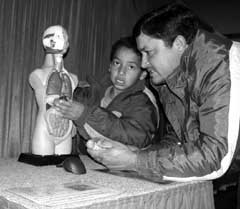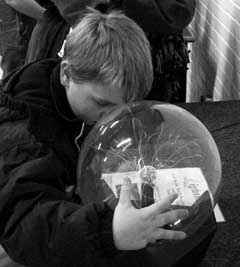University program gives kids hands-on experience
Elementary students use whisper dishes, a quake house, a magnetic circus and a Star Lab to learn about science, thanks to the Discovery on Wheels traveling outreach program.
The program has 35 hands-on exhibits and reached 30,000 students in their classrooms last year alone, said Caleb Larsen, the program’s coordinator.
“We do it so kids can get excited and see that science is fun rather than boring,” said Larsen, a sophomore biology major.
The exhibit is set up in school gymnasiums, where students spend 90 minutes with their teachers exploring the displays. The exhibit covers material that ties in with the core curriculum taught in each grade.
The exhibit travels to an average of two schools each week, and visits each school once per year.
Larsen said hands-on learning is one of the most important aspects of learning because it can teach children better than books can.
“The hands-on learning is just a lot of fun for them,” he said. “The best part is to see the kids that say, ‘Oh, now I get it.’ It’s hard to find application with reading. They read and don’t understand it. With hands-on, they see how it applies.”
Usually four classes at a time go to see the exhibit. They have a mini-assembly with a hydrogen balloon and a helium balloon to show the difference between flammable and nonflammable gases and a Ven De Graaf electrostatic generator, which makes a person’s hair stand on end, Larsen said. The students divide into four groups and go to different areas for about 20 minutes each, rotating until every child has been to every area. The exhibits are contained in a Star Lab, which is a mini planetarium, and three areas of science: natural forces, sound and light, and structure and design.
The Star Lab is 18 by 10 feet in area and includes a simulated night sky. Students learn about Greek and Roman mythology, Native American legends, constellations and the galaxy, according to the program’s Web site, www.usu.edu/discovery.
In the natural forces exhibits, students can experiment with magnets and learn about polarities and attraction and repulsion in the Magnetic Circus. With Velocity Tracks, children study friction, gravity and acceleration. Making Waves teaches them about centrifugal and centripetal forces, and at Weather Central, they learn about weather tools, like an anemometer, barometer, hygrometer, thermometer and rain gauge, according to the Web site.
The sound and light exhibits include Whisper Dishes, which teach about wavelengths; Pipes of Pan teaches pitches and sound waves and Personal Morphing, which teaches properties of light.
At the structure and design exhibits, students can experiment with the Resonance Towers to compare structural aspects of buildings to see how they withstand earthquakes. At Bugs Under Your Nose, students study insects under magnification and learn about mimicry. The Quake House is where children can test with a dollhouse to see how different setups withstand earthquakes. At the Gears Table, they experiment with applied force.
Sometimes after school, Discovery Family Nights are held where parents can come and see the program at their children’s schools.
“Discovery Family Nights are an opportunity for students to bring their parents back,” Larsen said. “It’s a good way to get parents back to school. The kids get excited about it, and their parents want to see what they’re talking about.”
The program also works with Boys’ and Girls’ Clubs in the afternoon at the REACH schools. REACH schools are those started by the 21st Century Community Learning Centers Grant, Larsen said.
Discovery on Wheels travels around the state and neighboring states, including schools in the Cache, Granite, Jordan and Davis districts. It will travel to St. George schools for a week, and goes to fairs during the summer – including some in Las Vegas, Caldwell, Idaho and Casper, Wyo.
“We bump it all around the state and go to some schools in Idaho,” Larsen said. “This is one of the largest outreach programs in the state and possibly the nation, and we are able to reach thousands of people at a time at fairs.”
The program was founded in 1995 as Leonardo on Wheels and was created by the Utah Science Center. It moved to Utah State University in fall of 1998 and changed its name to Discovery on Wheels. It is done in partnership with USU Extension and 4-H Club. Two people travel with it on the road. For more information, visit the Web site.
-kcartwright@cc.usu.edu

Christopher Jules, a second grade student and Flavio Molina, a Richmond resident, work on the anatomy of the body at the Discovery on Wheels parent night at Park Elementary School. (Photo by Amy Fuller)

Josh Smith, a third grade student at Park Elementary School in Richmond gets a closer look into the “Lightning Ball.” (Photo by Amy Fuller)

